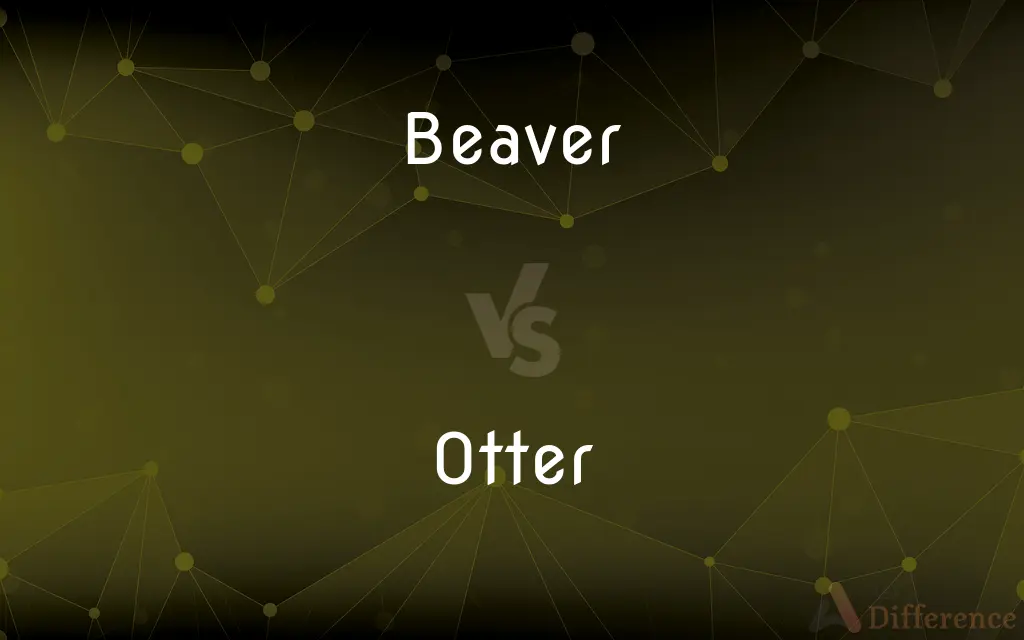Beaver vs. Otter — What's the Difference?
By Tayyaba Rehman — Updated on October 26, 2023
Beavers are large, semi-aquatic rodents known for building dams, while otters are sleek, aquatic mammals skilled in swimming and hunting fish.

Difference Between Beaver and Otter
Table of Contents
ADVERTISEMENT
Key Differences
Beavers are known for their impressive engineering skills, building dams and lodges in waterways. They have large, flat tails and strong teeth for cutting wood. Otters, on the other hand, are slender, agile swimmers, with long bodies and tails adapted for a life primarily in water.
Otters are carnivorous, feeding mainly on fish and small aquatic creatures. Beavers are herbivorous, eating mainly tree bark and aquatic plants. The dietary habits of these animals reflect their adaptations to their respective environments.
The habitat of beavers is usually freshwater bodies like rivers, lakes, and ponds where they can build their structures. Otters are more versatile, living in marine and freshwater environments, often along coastlines or riverbanks but without constructing homes like beavers.
Socially, beavers are known to live in family groups and exhibit complex social behaviors. Otters, depending on the species, can be solitary or social. Some otter species are known for their playful behavior.
Physically, beavers are generally bulkier and have a more robust appearance compared to the sleek and streamlined otters. This physical distinction corresponds with their differing lifestyles and environmental adaptations.
ADVERTISEMENT
Comparison Chart
Habitat Construction
Builds dams and lodges
Does not build structures
Diet
Herbivorous
Carnivorous
Tail Shape
Flat and broad
Long and rounded
Social Structure
Often live in family groups
Can be solitary or social
Body Shape
Bulky and robust
Sleek and streamlined
Compare with Definitions
Beaver
Dam Builder
A beaver's dam can alter entire ecosystems.
Otter
Aquatic Mammal
The otter glided effortlessly through the water.
Beaver
Flat-Tailed
The beaver used its tail to slap the water.
Otter
Streamlined Body
The otter's sleek body helps it swim fast.
Beaver
Family-Oriented
A family of beavers lived in the lodge.
Otter
Fish Hunter
An otter caught a fish with ease.
Beaver
Beavers are large, semiaquatic rodents in the genus Castor native to the temperate Northern Hemisphere. There are two extant species: the North American beaver (Castor canadensis) and the Eurasian beaver (C. fiber).
Otter
Versatile Habitat
Otters can live in both freshwater and marine environments.
Beaver
Either of two large semiaquatic rodents, Castor canadensis of North America or C. fiber of Eurasia, having thick brown fur, webbed hind feet, a broad flat tail, and sharp incisors used for gnawing bark and felling trees, with which they construct dams and underwater lodges.
Otter
Playful
Otters are known for their playful antics.
Beaver
The fur of a beaver.
Otter
Otters are carnivorous mammals in the subfamily Lutrinae. The 13 extant otter species are all semiaquatic, aquatic or marine, with diets based on fish and invertebrates.
Beaver
A top hat originally made of the underfur of a beaver.
Otter
A semiaquatic fish-eating mammal of the weasel family, with an elongated body, dense fur, and webbed feet.
Beaver
A napped wool fabric, similar to felt, used for outer garments.
Otter
A piece of board used to carry fishing bait in water.
Beaver
Vulgar Slang The female genitals.
Otter
Any of various aquatic or semiaquatic carnivorous mammals of the mustelid subfamily Lutrinae, having webbed feet and dense, dark brown fur.
Beaver
Offensive Slang A woman or girl.
Otter
The fur of one of these animals.
Beaver
A piece of armor attached to a helmet or breastplate to protect the throat or lower face.
Otter
An aquatic or marine carnivorous mammal in the subfamily Lutrinae of the family Mustelidae, which also includes weasels, polecats, badgers, and others.
Beaver
The visor on a helmet.
Otter
(gay slang) A hairy man with a slender physique, in contrast with a bear, who is more thickset.
Beaver
Of or relating to a beaver or beavers
Beaver fur.
A beaver hat.
Otter
(obsolete) annatto dye
Beaver
Constructed by beavers
Beaver dams.
Otter
Any carnivorous animal of the genera Lutra, Enhydra, and related genera of the family Mustelidae. Several species are described. They have large, flattish heads, short ears, and webbed toes. They are aquatic, and feed on fish. The sea otter (Enhydra lutris) also eats clams, crabs, starfish, abalone, and other marine animals; they may come to the surface, and lying on their backs using the stomach as a table, may be seen cracking open the shell of its prey with a rock. The common otter of Europe is Lutra vulgaris; the North American otter (or American otter) is Lutra Canadensis, which inhabits marshes, streams and rivers; other species inhabit South America and Asia. The North American otter adult is about three to four feet long (including the tail) and weighs from 10 to 30 pounds; the sea otter is commonly four feet long and 45 pounds (female) or 60 pounds (male). Their fur is soft and valuable, and in the nineteenth century they were hunted extensively. The sea otter was hunted to near extinction by 1900, and is now protected. Fewer than 3,000 sea otters are believed to live along the central California coast.
Beaver
To work diligently and energetically.
Otter
The larva of the ghost moth. It is very injurious to hop vines.
Beaver
To spot a beard in a game of beaver.
Otter
A corruption of Annotto.
Beaver
To work hard.
Otter
The fur of an otter
Beaver
To cut a continuous ring around a tree that one is felling.
Otter
Freshwater carnivorous mammal having webbed and clawed feet and dark brown fur
Beaver
(backgammon) After being doubled, to immediately double the stakes again, a move that keeps the doubling cube on one’s own side of the board.
Beaver
(countable) A semiaquatic rodent of the genus Castor, having a wide, flat tail and webbed feet.
Beaver
The fur of the beaver.
Beaver
(countable) A hat, of various shapes, made from a felted beaver fur (or later of silk), fashionable in Europe between 1550 and 1850.
Beaver
(North American) Beaver pelts as an article of exchange or as a standard of value.
Beaver
Beaver cloth, a heavy felted woollen cloth, used chiefly for making overcoats.
Beaver
A brown colour, like that of a beaver.
Beaver
A move in response to being doubled, in which one immediately doubles the stakes again, keeping the doubling cube on one’s own side of the board.
Beaver
Senseid|en|member of the youngest wing of the Scout movement}} {{alternative case form of Beaver.
Beaver
Senseid|en|part of a helmet}} {{alternative spelling of bevor.
Beaver
An amphibious rodent, of the genus Castor.
Beaver
The fur of the beaver.
Beaver
A hat, formerly made of the fur of the beaver, but now usually of silk.
A brown beaver slouched over his eyes.
Beaver
Beaver cloth, a heavy felted woolen cloth, used chiefly for making overcoats.
Beaver
A man's beard.
Beaver
The hair on a woman's pubic area; - vulgar.
Beaver
A woman; - vulgar and offensive.
Beaver
A person who works enthusiastically and diligently; - used especially in the phrase eager beaver.
Beaver
That piece of armor which protected the lower part of the face, whether forming a part of the helmet or fixed to the breastplate. It was so constructed (with joints or otherwise) that the wearer could raise or lower it to eat and drink.
Beaver
The soft brown fur of the beaver
Beaver
A full beard
Beaver
A man's hat with a tall crown; usually covered with beaver or silk
Beaver
A movable piece of armor on a medieval helmet used to protect the lower face
Beaver
A hat made of beaver fur or similar material
Beaver
Large semiaquatic rodent with webbed hind feet and a broad flat tail; construct complex dams and underwater lodges
Beaver
Work hard on something
Beaver
Semi-Aquatic Rodent
The beaver was busy building its dam.
Beaver
Herbivorous
Beavers mainly eat bark and plants.
Common Curiosities
Do beavers and otters eat the same food?
No, beavers are herbivorous, and otters are carnivorous.
What is an otter?
An aquatic mammal skilled in swimming and hunting fish.
Can otters build dams like beavers?
No, otters do not construct dams.
What is a beaver?
A large, semi-aquatic rodent known for building dams.
Are beavers social animals?
Yes, they often live in family groups.
What's unique about a beaver's tail?
It's flat and broad, used for swimming and signaling.
Do otters build homes?
No, they do not construct homes like beavers.
Are beavers good swimmers?
Yes, they are excellent swimmers.
Are all otters social?
It varies; some species are solitary, while others are social.
How do otters hunt?
They are skilled swimmers and catch fish or other small aquatic creatures.
Do beavers live in marine environments?
No, they are primarily found in freshwater.
What's the size difference between beavers and otters?
Beavers are generally bulkier than otters.
Can beavers live in saltwater?
They prefer freshwater habitats.
Are otters found worldwide?
Yes, in various aquatic environments across the globe.
Do otters have any unique behaviors?
Yes, they are known for being playful and using tools.
Share Your Discovery

Previous Comparison
Ductile vs. Tensile
Next Comparison
Epilogue vs. ConclusionAuthor Spotlight
Written by
Tayyaba RehmanTayyaba Rehman is a distinguished writer, currently serving as a primary contributor to askdifference.com. As a researcher in semantics and etymology, Tayyaba's passion for the complexity of languages and their distinctions has found a perfect home on the platform. Tayyaba delves into the intricacies of language, distinguishing between commonly confused words and phrases, thereby providing clarity for readers worldwide.














































